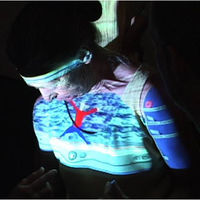2010
Interactive Performance: Visual Culture in Dance
Visual culture is a complex matrix of imagery that reflects and identifies the everyday world. Mediated technology as seem in photography, TV, and the Internet join the social practices of advertising and marketing, creating a sociocultural sphere that is exemplified by commercialized imagery (Sullivan, 2003). The research seeks to provide artistic vision and technological innovation, allowing the students the opportunity to create, influence and interact with the technical elements in an immediate way. As the dancers, actions generate new internal imagery, we suppose that the resulting experience will enhance the audience’s knowledge in dance as well. Participants can activate, respond to, and ultimately create new relationships with the dance and technology.
Interactive Performance: Visual Culture in Dance seeks answers to the following questions:
-
Specifically, how will participants interact with and utilize dance technology to express their knowledge of their vision and their voice as teenagers?
-
In what ways will discussions of visual culture inform students understanding of their awareness of community, society, culture, self-expression and creative process? How might the answers to these questions delimit or inform our understanding of culture, dance and pedagogy.
-
How might explorations with electronic media, new media, video dance technology and choreography be expressive of participant’s worldview?
Interactive performance: visual culture in dance investigates the use of interactive performance as a way for teenager’s adults to create choreography, which expresses their interpretations of visual culture. Undergraduate dance students, Leslie Smith and Taylor Ferguson will collaborate with dance faculty Dr. Mila Parrish and the students and teachers from 4 school in Columbia, SC to create and implement visual culture dance curriculum and to create interactive dance performances. The research team will work with 120 students from two inner city middle and two high schools.
In the year-long research project the research team will instruct and mentor the student participants in the development and production of their own interactive dance technology performance. In the process, of developing an interactive dance, the students will employ critical thinking and problem-solving skills by discussing, analyzing, creating, collaborating, rehearsing, and performing their own dance works. Participants will discuss visual culture, determine their views on the subject and create works of interactive dance expressive of their beliefs. In the process, they will experience first-hand the profession of choreographers, editors, designers, cinematographers, and directors. In the spring, each school will hold an interactive performance for parents and friends.
We hope to inform student participants of the impact of visual culture as an interpretive process, and how culturally charged visual images, act as language and in turn signify cultural codes. Enlightening student participants that visual imagery, including dance, does not stand outside of culture; rather it is contextualized by both personal and socioeconomic conditions and is reflexive and constructed with the artist and the audience creating meaning based upon their social class, gender and race.
Additionally, we will be adopting the educational principles of noted educator and curricular integration proponent, James Beane. We will implement some of Dr. Beane’s (2005), views on student-centered curriculum specifically: (1) Focusing on widely shared concerns of teenagers and the larger world; (2) Serving the teenager population where they are and address what they are interested in today; (3) Appreciating that teenagers are real people with real concerns; (4) Emergent themes will come organically from the concerns of the students rather than the interest of the research team and dance teacher. Beane proposes that integrated curriculum help students develop skills related to communication, problem solving, research and social action. He proposes that adolescents can become acquainted with a rich array of facts and complex and multi-faceted concepts from a wide variety of sources with curricular integration resulting in metacognitive learning. Curricular features that will guide our process include: (1) The adoption of a constructivist pedagogy; (2) Awareness that knowledge and skills are taken out of abstract discipline specific categories and repositioned in the context of thematic units; and, (3) The support of authentic integration of affect and cognition.



